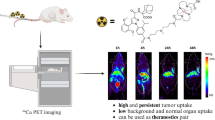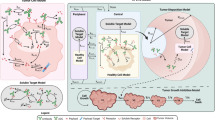Abstract
Purpose
The cellular interrelation between intracellular concentrations of unbound carfilzomib, a second-generation proteasome inhibitor, and subsequent proteasome inhibition and effect on cell viability are unknown and were evaluated for two different exposure regimens: A high dose bolus regime of 500 nM for 1 h followed by 47 h in drug-free media vs. 48-h continuous exposure to 10 nM.
Methods
Eight multiple myeloma cell lines were exposed to either one of the two exposure regimens. We quantified the intracellular unbound carfilzomib fraction up to 48 h with a new ultra-performance liquid chromatography coupled to tandem mass spectrometry (UPLC/MS/MS) method. Intracellular concentrations were compared to simultaneously determined cell viability (AlamarBlue® assay) and proteasomal subunit activity (ProGlo™ assay).
Results
Within the first 10 min, the proportional intracellular enrichment of unbound carfilzomib was higher (313 nM; 62.6%) for the exposure to 500 nM compared to 10 nM (1.93 nM; 19.3%). However, after 1 h, an intracellular/extracellular concentration equilibrium was reached with both settings. At low exposure concentrations, drug removal after 1 h diminished carfilzomib efficacy. Moreover, proteasomal activity recovered when exposed to 10 nM for 48 h. However, when exposure concentration was high (500 nM) proteasome inhibition was complete and sustained even with drug removal after 1 h.
Conclusions
We demonstrated that the carfilzomib concentration gradient determines cellular uptake kinetics. The uptake kinetics in turn affects binding, saturation, and activity of the proteasome. Together, these data underscore the importance of steep concentrations for the in vitro efficacy of carfilzomib.





Similar content being viewed by others
References
Lawasut P, Chauhan D, Laubach J, Hayes C, Fabre C, Maglio M, Mitsiades C, Hideshima T, Anderson KC, Richardson PG (2012) New proteasome inhibitors in myeloma. Current Hematol Malig Rep 7:258–266
Teicher BA, Tomaszewski JE (2015) Proteasome inhibitors. Biochem Pharmacol 96:1–9
Demo SD, Kirk CJ, Aujay MA, Buchholz TJ, Dajee M, Ho MN, Jiang J, Laidig GJ, Lewis ER, Parlati F, Shenk KD, Smyth MS, Sun CM, Vallone MK, Woo TM, Molineaux CJ, Bennett MK (2007) Antitumor activity of PR-171, a novel irreversible inhibitor of the proteasome. Cancer Res 67:6383–6391
Kuhn DJ, Chen Q, Voorhees PM, Strader JS, Shenk KD, Sun CM, Demo SD, Bennett MK, van Leeuwen FW, Chanan-Khan AA, Orlowski RZ (2007) Potent activity of carfilzomib, a novel, irreversible inhibitor of the ubiquitin-proteasome pathway, against preclinical models of multiple myeloma. Blood 110:3281–3290
Parlati F, Lee SJ, Aujay M, Suzuki E, Levitsky K, Lorens JB, Micklem DR, Ruurs P, Sylvain C, Lu Y, Shenk KD, Bennett MK (2009) Carfilzomib can induce tumor cell death through selective inhibition of the chymotrypsin-like activity of the proteasome. Blood 114:3439–3447
Meister S, Schubert U, Neubert K, Herrmann K, Burger R, Gramatzki M, Hahn S, Schreiber S, Wilhelm S, Herrmann M, Jäck HM, Voll RE (2007) Extensive immunoglobulin production sensitizes myeloma cells for proteasome inhibition. Cancer Res 67:1783–1792
Mitsiades CS (2015) Therapeutic landscape of carfilzomib and other modulators of the ubiquitin-proteasome pathway. J Clin Oncol 33:782–785
Clemens J, Seckinger A, Hose D, Theile D, Longo M, Haefeli WE, Burhenne J, Weiss J (2015) Cellular uptake kinetics of bortezomib in relation to efficacy in myeloma cells and the influence of drug transporters. Cancer Chemother Pharmacol 75:281–291
Dettmer S, Theile D, Schafer J, Seckinger A, Burhenne J, Weiss J (2016) Proteasome inhibition correlates with intracellular bortezomib concentrations but not with antiproliferative effects after bolus treatment in myeloma cell lines. Naunyn-Schmiedeberg’s Arch Pharmacol 389:1091–1101
Clemens J, Longo M, Seckinger A, Hose D, Haefeli WE, Weiss J, Burhenne J (2014) Stability of the proteasome inhibitor bortezomib in cell based assays determined by ultra-high performance liquid chromatography coupled to tandem mass spectrometry. J Chromatogr A 1345:128–138
Wang Z, Yang J, Kirk C, Fang Y, Alsina M, Badros A, Papadopoulos K, Wong A, Woo T, Bomba D, Li J, Infante JR (2013) Clinical pharmacokinetics, metabolism, and drug-drug interaction of carfilzomib. Drug Metab Dispos 41:230–237
Bianchi G, Oliva L, Cascio P, Pengo N, Fontana F, Cerruti F, Orsi A, Pasqualetto E, Mezghrani A, Calbi V, Palladini G, Giuliani N, Anderson KC, Sitia R, Cenci S (2009) The proteasome load versus capacity balance determines apoptotic sensitivity of multiple myeloma cells to proteasome inhibition. Blood 113:3040–3049
Kortuem KM, Stewart AK (2013) Carfilzomib. Blood 121:893–897
Sestak V, Roh J, Klepalova L, Kovarikova P (2016) A UHPLC-UV-QTOF study on the stability of carfilzomib, a novel proteasome inhibitor. J Pharm Biomed Anal 124:365–373
Badros AZ, Vij R, Martin T, Zonder JA, Kunkel L, Wang Z, Lee S, Wong AF, Niesvizky R (2013) Carfilzomib in multiple myeloma patients with renal impairment: pharmacokinetics and safety. Leukemia 27:1707–1714
Meiners S, Heyken D, Weller A, Ludwig A, Stangl K, Kloetzel PM, Kruger E (2003) Inhibition of proteasome activity induces concerted expression of proteasome genes and de novo formation of Mammalian proteasomes. J Biol Chem 278:21517–21525
Dettmer S, Theile D, Seckinger A, Burhenne J, Weiss J (2015) Fetal calf sera can distort cell-based luminescent proteasome assays through heat-resistant chymotrypsin-like activity. Anal Biochem 471:23–25
Cusack JC Jr, Liu R, Houston M, Abendroth K, Elliott PJ, Adams J, Baldwin AS Jr (2001) Enhanced chemosensitivity to CPT-11 with proteasome inhibitor PS-341: implications for systemic nuclear factor-kappaB inhibition. Cancer Res 61:3535–3540
Han B, Yao W, Oh YT, Tong JS, Li S, Deng J, Yue P, Khuri FR, Sun SY (2015) The novel proteasome inhibitor carfilzomib activates and enhances extrinsic apoptosis involving stabilization of death receptor 5. Oncotarget 6:17532–17542
Hideshima T, Mitsiades C, Akiyama M, Hayashi T, Chauhan D, Richardson P, Schlossman R, Podar K, Munshi NC, Mitsiades N, Anderson KC (2003) Molecular mechanisms mediating antimyeloma activity of proteasome inhibitor PS-341. Blood 101:1530–1534
Williams SA, McConkey DJ (2003) The proteasome inhibitor bortezomib stabilizes a novel active form of p53 in human LNCaP-Pro5 prostate cancer cells. Cancer Res 63:7338–7344
Mishima Y, Santo L, Eda H, Cirstea D, Nemani N, Yee AJ, O’Donnell E, Selig MK, Quayle SN, Arastu-Kapur S, Kirk C, Boise LH, Jones SS, Raje N (2015) Ricolinostat (ACY-1215) induced inhibition of aggresome formation accelerates carfilzomib-induced multiple myeloma cell death. Br J Haematol 169:423–434
Zang Y, Thomas SM, Chan ET, Kirk CJ, Freilino ML, DeLancey HM, Grandis JR, Li C, Johnson DE (2012) The next generation proteasome inhibitors carfilzomib and oprozomib activate prosurvival autophagy via induction of the unfolded protein response and ATF4. Autophagy 8:1873–1874
Acknowledgements
The authors like to thank Stephanie Rosenzweig, Magdalena Longo, and Andrea Deschlmayr for their excellent technical support.
Author information
Authors and Affiliations
Corresponding author
Ethics declarations
Funding
This work was supported in part by grants from the Deutsche Forschungsgemeinschaft (SFB/TRR79, subproject B10; Bonn, Germany).
Conflict of interest
All authors declare that they have no conflict of interest.
Ethical approval
This article does not contain any studies with human participants or animals performed by any of the authors.
Electronic supplementary material
Below is the link to the electronic supplementary material.
Rights and permissions
About this article
Cite this article
Schäfer, J., Welti, L., Seckinger, A. et al. Cellular effect and efficacy of carfilzomib depends on cellular net concentration gradient. Cancer Chemother Pharmacol 80, 71–79 (2017). https://doi.org/10.1007/s00280-017-3335-4
Received:
Accepted:
Published:
Issue Date:
DOI: https://doi.org/10.1007/s00280-017-3335-4




